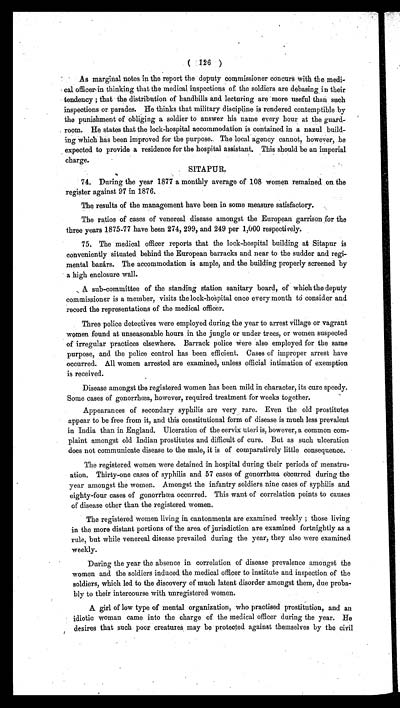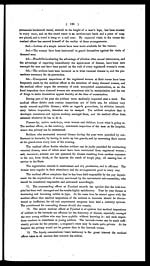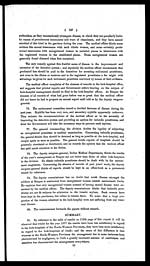Medicine - Institutions > Lock hospitals > Annual report on the working of the lock hospitals in the North-Western Provinces and Oudh > Fourth annual report on the working of the lock-hospitals in the North-Western Provinces and Oudh for the year 1877
(134) Page 126
Download files
Individual page:
Thumbnail gallery: Grid view | List view

( 126 )
As marginal notes in the report the deputy commissioner concurs with the medi-
cal officer in thinking that the medical inspections of the soldiers are debasing in their
tendency; that the distribution of handbills and lecturing are more useful than such
inspections or parades. He thinks that military discipline is rendered contemptible by
the punishment of obliging a soldier to answer his name every hour at the guard-
room. He states that the lock-hospital accommodation is contained in a nazul build-
ing which has been improved for the purpose. The local agency cannot, however, be
expected to provide a residence for the hospital assistant. This should be an imperial
charge.
SITAPUR.
74 During the year 1877 a monthly average of 108 women remained on the
register against 97 in 1876.
The results of the management have been in some measure satisfactory.
The ratios of cases of venereal disease amongst the European garrison for the
three years 1875-77 have been 274, 299, and 249 per 1,000 respectively.
75 The medical officer reports that the lock-hospital building at Sitapur is
conveniently situated behind the European barracks and near to the sudder and regi-
mental bazárs. The accommodation is ample, and the building properly screened by
a high enclosure wall.
A sub-committee of the standing station sanitary board, of which the deputy
commissioner is a member, visits the lock-hospital once every month to consider and
record the representations of the medical officer.
Three police detectives were employed during the year to arrest village or vagrant
women found at unseasonable hours in the jungle or under trees, or women suspected
of irregular practices elsewhere. Barrack police Were also employed for the same
purpose, and the police control has been efficient. Cases of improper arrest have
occurred. All women arrested are examined, unless official intimation of exemption
is received.
Disease amongst the registered women has been mild in character, its cure speedy.
Some cases of gonorrhœa, however, required treatment for weeks together.
Appearances of secondary syphilis are very rare. Even the old prostitutes
appear to be free from it, and this constitutional form of disease is much less prevalent
in India than in England. Ulceration of the cervix uteri is, however, a common com-
plaint amongst old Indian prostitutes and difficult of cure. But as such ulceration
does not communicate disease to the male, it is of comparatively little consequence.
The registered women were detained in hospital during their periods of menstru-
ation. Thirty-one cases of syphilis and 57 cases of gonorrhœa occurred during the
year amongst the women. Amongst the infantry soldiers nine cases of syphilis and
eighty-four cases of gonorrhœa occurred. This want of correlation points to causes
of disease other than the registered women.
The registered women living in cantonments are examined weekly; those living
in the more distant portions of the area of jurisdiction are examined fortnightly as a
rule, but while venereal disease prevailed during the year, they also were examined
weekly.
During the year the absence in correlation of disease prevalence amongst the
women and the soldiers induced the medical officer to institute and inspection of the
soldiers, which led to the discovery of much latent disorder amongst them, due proba-
bly to their intercourse with unregistered women.
A girl of low type of mental organization, who practised prostitution, and an
idiotic woman came into the charge of the medical officer during the year. He
desires that such poor creatures may be protected against themselves by the civil
Set display mode to: Large image | Zoom image | Transcription
Images and transcriptions on this page, including medium image downloads, may be used under the Creative Commons Attribution 4.0 International Licence unless otherwise stated. ![]()
| Permanent URL | https://digital.nls.uk/75111234 |
|---|




